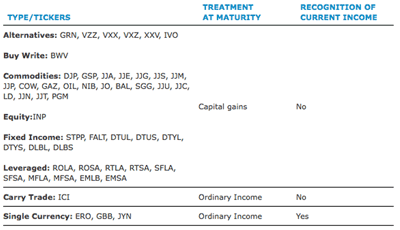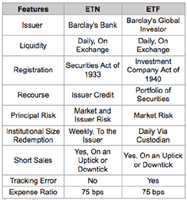Here is a helpful guide explaining key tax and risk implications of exchange traded notes (ETNs) and more popular exchange traded funds (ETFs).
ETN, short for exchange traded note, is the investment industry's latest acronym. ETNs are similar to exchange traded funds, or ETFs, but the two differ in structure.
ETNs are issued by Barclays Bank, the ETF industry's largest provider, and one example is the iPath S&P GSCI Crude Oil Total Return Index ETN (OIL).
In this article, we'll explain this innovative approach to index trading and compare it to its cousin, the ETF.
How ETFs Differ from ETNs
ETNs are structured products that are issued as senior debt notes by Barclays, while ETFs represent a stake in an underlying commodity.
Barclays is a 300-year-old bank with $1.5 trillion in assets and an 'AA' credit rating from Standard & Poor's. This provides ETNs with a fairly dependable backing, but even with this kind of credibility, ETNs are not free of credit risk.
After all, Barclays Bank will never be as safe as a central bank, such as the Bank of England. In the 1990’s, for example, Barings Bank (which was as reputable as Barclays at the time) collapsed as a result of the large losses incurred by a speculative trader employed at the bank.
Tax Treatment
The tax treatment of ETNs currently depends on the type of ETN traded.
According to Barclay's Web site:
Barclays and investors agree to treat all iPath ETNs, except single currency ETNs, for all tax purposes as prepaid contracts with respect to the relevant index. If such iPath ETNs are so treated, investors should recognize gain or loss upon the sale, redemption or maturity of their iPath ETNs in an amount equal to the difference between the amount they receive at such time and their cost basis in the securities. You generally agree to treat such gain or loss as capital gain or loss, except with respect to those iPath ETNs for which you agree to treat such gain or loss as ordinary, as detailed in the chart below.
Revenue ruling 2008-1, issued on December 7, 2007 (and is the latest ruling at the time of this writing), holds that certain financial instruments linked directly to the value of a foreign currency—regardless of whether the instrument is privately offered, publicly offered, or traded on an exchange—should be treated like debt for federal tax purposes.
Revenue Ruling 2008-1 extends to iPath single currency ETNs. This means that any interest accrued (net of fees) during the life of the note is taxable to investors, even though the interest is reinvested and not paid out until the holder sells the ETN or the note matures.
It also means that a gain or loss from the sale or redemption of the notes will be ordinary and investors will not be able to elect capital gain treatment.
The revenue ruling does not apply to ETNs that are linked to equities, fixed income, commodities, or certain alternatives. On December 7, 2007, the IRS also issued notice 2008-2 asking for comments on the appropriate tax treatment of instruments such as the equity and commodity ETNs. The IRS has not issued additional guidance on this issue.
Tax treatment does change frequently, so it is always a good idea to check with your accountant before trading or investing these instruments.
NEXT: How to Know Which Security Is Best for You
|pagebreak|Risk Factors
Outside of the tax treatment, the difference between ETNs and ETFs comes down to credit risk versus tracking risk. Because ETNs possess credit risk, if Barclays goes bankrupt, the investor may not receive the return he or she was promised.
An ETF, on the other hand, has virtually no credit risk, but there is tracking risk involved with holding an ETF. In other words, there is a possibility that the ETF's returns will differ from the returns of its underlying index.
The following chart represents a comparison of the above-mentioned crude oil ETF and ETN.
So Which Security Is Better?
Now that you have a better understanding of the differences between ETN and ETF, which one should prevail?
To some degree, that will be determined by your tax bracket and your investment time horizon. While the biggest benefit of some ETNs is that the entire gain is treated as a capital gain, this gain is also deferred until the security is either sold or matures—something that should not be taken lightly by tax-conscious, long-term investors.
However, giving taxes higher priority over the quality of an investment can be perilous—the tax code and tax rates are always subject to change.
The absence of tracking risk is also of some value for ETN investors, but it should not be overrated because this has been a problem with some ETFs that have not tracked the index or instruments as closely as traders or investors had hoped. (Read more about the issue of “contango” here.)
Conclusion
The big difference between ETNs and ETFs comes down to credit risk and tax treatment. While ETNs may have some credit risk with the issuing company (Barclay’s), some ETFs may suffer from tracking problems.
Deciding which aspect is more important (tax treatment or risk) will help you decide which instrument is best suited for your own trading style and risk tolerance.
We will likely see many more ETNs in the future as asset classes like timber, foreign currency bonds, foreign commercial real estate, and equity volatility in the US become more popular trading vehicles for profit or for hedging other positions.
By the Staff at Investopedia.com






















